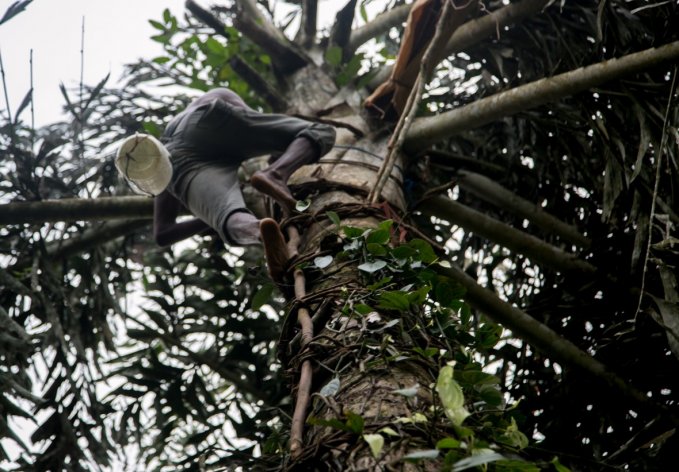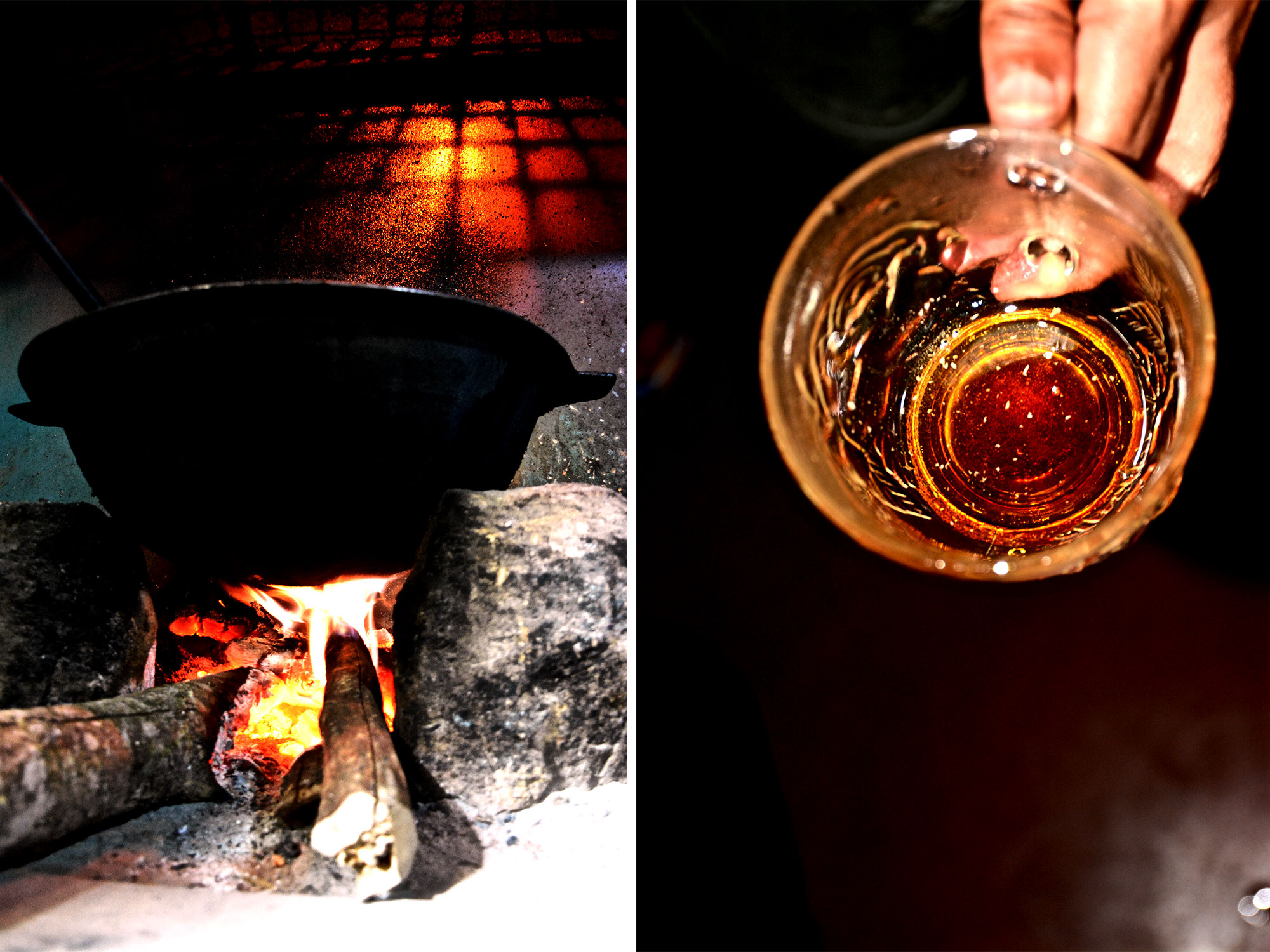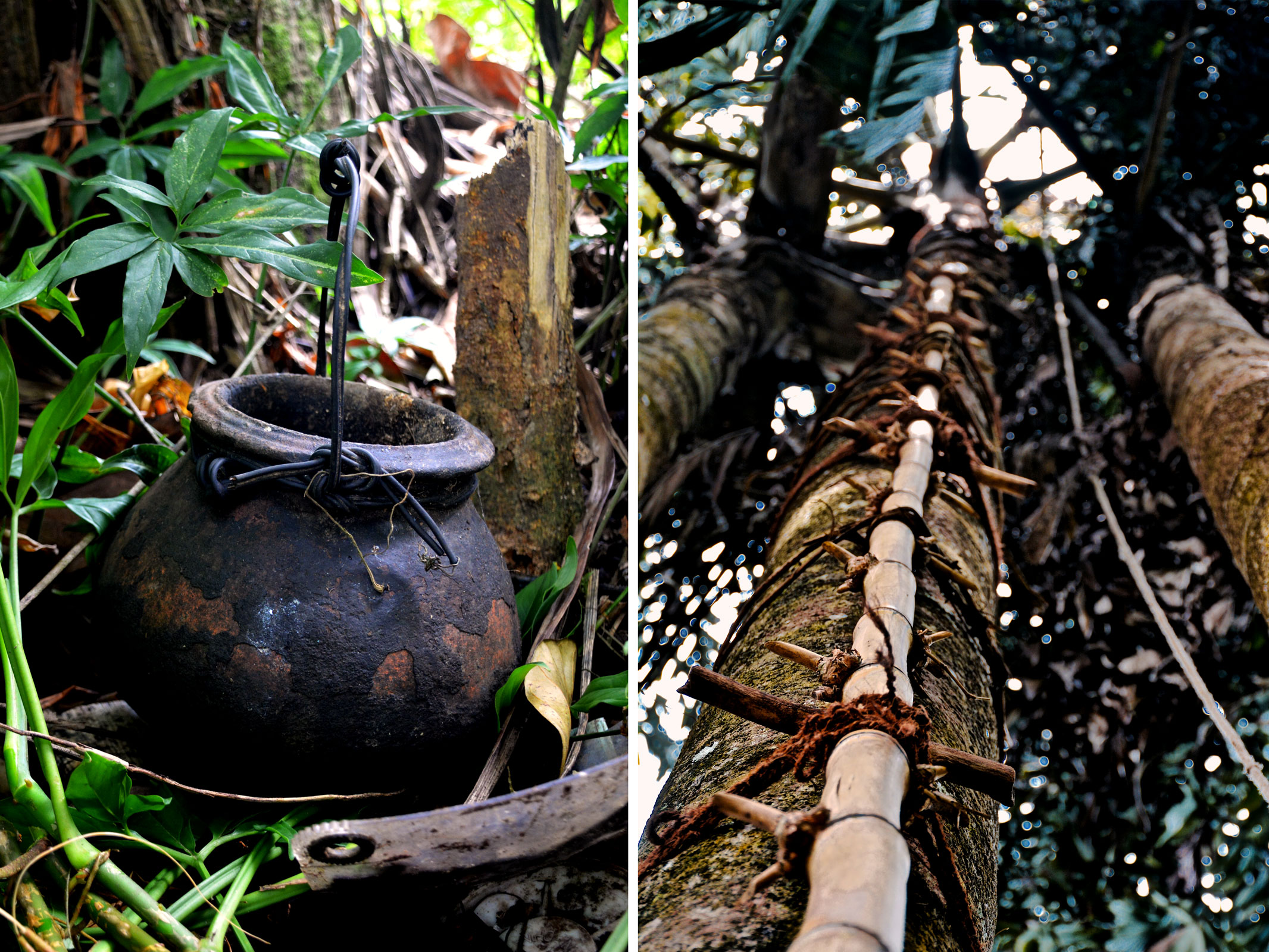
Kithul pani—it goes on curd, in watalappan, and when reduced, becomes hakuru or jaggery. A sugary Sri Lankan staple, this boiled-down sap of the kithul, or fishtail palm, has a long history steeped in tradition, as does the arduous, labour-intensive process used to make it.
This process starts with tapping: the beady, vine-like flowers of the palm are pierced by a tapper, and drool their sap into a pot hung under the inflorescence. Each palm can be tapped around seven times in its lifetime, with each subsequent draw usually yielding less than the last. According to Dr. Sudarshana Somasiri, a researcher at the Industrial Technology Institute (ITI), tappers “will typically climb their palms twice a day” to make sure any cuts healed by the plant are reopened and re-tapped.
This raw, watery sap is white and frothy, clinically alive with yeast fermenting it — potentially into kithul toddy or ra. To avoid this, Gunewardena told us, it is “boiled down pretty much immediately” over a timber fire, which gives the treacle its woody undertones and its viscous consistency. Once boiled, the pani is ready for the plate — preserved au naturale, the treacle can last a couple of months at best.

This is kithul pani as it has been for generations — but when was the last time you tasted the timber in your treacle? With the syrup having become renowned for adulteration with added sugar in the modern marketplace, a complex flavour and a true-to-tradition treacle have been sacrificed to supermarket standardisation, and mass production. While the accessibility garnered from our modern approach to food is nothing to scoff at, there is a case to be made about what is lost with the growing scarcity of an unadulterated pani.
Low-Yield, High-Cost
To make kithul pani is “a tradition that has been passed down,” says Chanchala Gunewardena, the entrepreneur behind Kimbula Kithul, a food startup making kithul pani without added sugar. For the last 11 months, she has been working to make an unadulterated standard for the treacle. Her idea of kithul pani being an heirloom product is corroborated by a 2005 study done by Dr. M Seneviratne, a researcher at the Department of Export Agriculture (DEA). The study found that “approximately 73% of tappers were descended from traditional kithul tapping families.”
“It is a family business,” Gunewardena said. “[But] it’s not a ‘men’s only’ thing—they are predominantly the tappers—but often the wife is very much involved in the boiling and sale of the product.” This small-scale, family-centric nature of kithul collection at present, combined with the palms being a “low-yield product,” mean that making the treacle is a labour-intensive process. To mitigate this combination of high-cost and low-yield, some producers of treacle take various shortcuts and liberties in the production process.

“Added sugar,” remarked Gunewardena, “has become the bane of this industry.” Mixed into the watery sap, these adulterations make a single yield of boiled-down treacle larger in quantity, yet just as sweet. This desire to adulterate is understandable, because when “[tappers] boil down the sap they lose a tonne of product — upto half of the yield,” which drives up the cost of production, Gunewardena said.
According to the DEA’s 2016 study on the adulteration of kithul sap, 11.5% of kithul tappers admitted to adding sugar to their sap on a regular basis, and all 304 of the tappers questioned in the survey said “they had added sugar at least once to collect sap when they detected fermentation [had] initiated.” The research found that premature fermentation, along with an unusually watery sap—especially during the monsoon season—constituted the most common reasons for adulterating pre-treacle sap with sugar.
But it’s the middlemen who warrant most of the blame, says Dr. Somasiri. “It is neither the tappers nor the manufacturers who usually add sugar to kithul products,” he told Roar Media, “but rather intermediaries trying to maximise profit.” This means that the DEA’s statistics on tappers who add sugar may be an underestimation of how often the kithul products consumers receive are adulterated. According to Somasiri: “There are some [unadulterated] products, but added sugar is quite commonplace in the market.”
This shortcut to a higher yield is at the expense of subtleties in the kithul pani’s traditionally varied and complex taste: woody or fruity notes, and the occasional savoury treacle are often lost. “What the market has been doing recently is standardising the taste,” Gunewardena remarked. “For me, knowing the potential of tastes a kithul pani can have, it’s been a very sad standard.”
Added sugar can sometimes even affect the consumer’s health. Dr. Somasiri, who is currently working on characterising the Glycaemic Index (GI) of kithul, said: “Kithul is a low-GI food. There are a range of antidiabetic, antioxidant, and antihypertensive [used for the treatment of high blood pressure] compounds naturally occuring in kithul sap.” According to Somasiri, refined cane sugar, which has a high-GI, shrouds these benefits when added to kithul sap — benefits that could potentially aid a country with over 1 million diabetics, and where just over 30% of citizens over 60 suffer from high blood pressure.
Propping Up The Pani
Is an unadulterated norm for kithul pani feasible, given how long it takes to make? There are certainly some hard limitations on maximising the production of a syrup dependent on a plant which takes from 12–15 years to mature, with a tapping potential limited to a few batches in its lifetime. Despite this, there has been a plethora of anecdotal and scientific techniques devised to help the kithul industry work around these restraints. Sorting these methods into fact and fiction has been difficult in its own right and, according to Gunewardena, “marrying traditional approaches with scientific research that has been gleaned from the ITI has yet to find its perfect match.”
The criteria for this perfect match lie in making sure the taste of the pani isn’t compromised, and that the cultivation of kithul palms remains sustainable. “There was a worry amongst tappers that what was being done to increase yield was impacting taste, and that draining the flower too much was ruining the plant for future use,” Gunewardena said. Such worries mirror the fears of the consumer. Small, controlled steps are necessary to ensure the product remains true to its history and potential, as well as to avoid ruining batches of kithul pani in the meantime, on which farmers are dependent for income.
Dr. Somasiri, in his work at the ITI, had this in mind when he helped develop the Kithul Activation and Sap Production Enhancing Reagent (KASPER). This product “stimulates the kithul flowers, to encourage them to secrete more sap.” He has also made test-kits for kithul collectors to quantify the cane sugar content of the sap they buy. Workshops organised by the ITI reached over 20,000 tappers a few years ago, and taught them about the products and protocols—like KASPER—that help maximise the yields of kithul palms, reducing the need to adulterate to inflate the volume of treacle produced. Similarly, the DEA found through its own research that simply making sap-collecting pots watertight dramatically reduced how diluted each yield was, making it unnecessary for tappers to add sugar to mitigate the wateriness of each batch.
There is also room for optimisation after the sap has been collected. “The boiling,” for example, “is typically done in a deep pot — essentially a hopper-pot expanded,” explained Gunewardena. “So the kithul is being boiled at different speeds within the pot, because of the different depths. This means the process overall takes longer, and the treacle has to be continuously stirred.” Researchers at the ITI suggested using a “flatter, cake-tray type pot to boil the kithul, so the distribution of heat is more even.”

Tomorrow’s Treacle
According to Dr. Somasiri, industrialisation is the best-fit future for kithul. “Almost all kithul cultivation is with wild plants,” he said. “We can increase kithul production just by tapping more palms, grown in a systematic, farm-like manner.” DEA reports found that 89,855 fishtail palms were tapped by 29,607 tappers in 2016, which constituted 16% of some 30 million tappable trees in the country. This massive untapped potential is partly because farmers will typically tend to other crops in tandem with the fishtail palms—only 7% of tappers, according to the DEA, see tapping as their main livelihood—but is also due to the sheer effort required of tappers to climb trees multiple times a day, making tapping more than three or four palms simply not worth their time. “Automating this process will make tapping more financially viable,” claims Somasiri. Without pots and ladders, tappers can collect sap around the clock from more palms, and can focus on growing the palms more effectively to increase yield, and on boiling down the sap more efficiently to spare time and effort.

There is also room for diversification. With the ‘coconut revolution’ a few years ago, consumers saw a myriad of repurposed coconut products on the shelves, such as jams, spreads, and virgin oil. In this vein, researchers at the ITI have been working on kithul-based drinks, jams, and a refined sugar extracted from kithul, in the hope that the palm won’t be forgotten, and that its sap’s health benefits won’t be ignored.
For a product with such versatility in visage and taste—from light to dark and from sweet to savoury—just tracking the variables in the production process that cause these variations can be immensely helpful in engineering a refined pani. “There are so many factors that affect the taste, like the age of the fruit, or the type of fire used to boil [the sap],” explained Gunewardena. “If we could figure out how these work, we can knowingly produce different ‘types’ of kithul. The tappers don’t really watch the variables that go into a batch, and therefore can’t easily replicate an especially good one.”
In this way, studying the kithul palm and the quirks of its sap will hopefully open the doors to a tastier, healthier, and more nuanced treacle, and will allow this Sri Lankan syrup to become competitive on an international market. Despite the palm’s presence across the subcontinent and Southeast Asia, kithul treacle and hakuru seem to be unique to Sri Lankan cuisine. This exclusivity that the island’s kithul enjoys on the global stage has led ambitious manufacturers, nutritionists, and foodies to posit the pani as an up-and-coming rival to Canada’s maple syrup — but this is dependent on its health benefits being thoroughly researched and formalised, and its flavour being expressed in all its complexity. As Gunewardena summarises, “[the treacle] can be dark and smoky, or light in colour and really fruity, and everything that exists in between on that spectrum — the promise of [kithul pani] is immense.”








